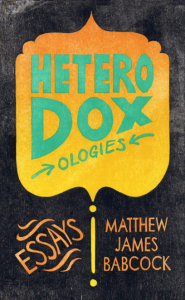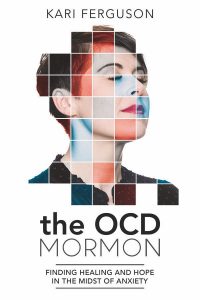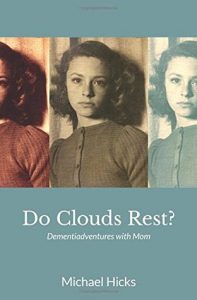We are pleased to announce the 2017 Association for Mormon Letters awards finalists in Creative Non-Fiction and Religious Non-Fiction. The final awards will be announced and presented at the Mormon Scholars in the Humanities Conference, held at Brigham Young University on March 23. The finalists and winners are chosen by juries of authors, academics, and critics. The finalist announcements include blurbs about each of the books and author biographies, adapted from the author and publisher websites.
“Creative Non-fiction” includes memoirs and collections of personal essays. “Religious Non-fiction” refers to a wide variety of LDS religious studies books, including scriptural studies, theology, social studies, and devotional literature. The category does not include histories or biographies, as the Mormon History Association already does a good job of recognizing those books.
Creative Non-Fiction
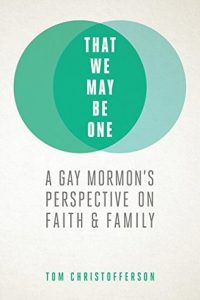 Tom Christofferson. That We May Be One: A Gay Mormon’s Perspective on Faith and Family. Deseret Book.
Tom Christofferson. That We May Be One: A Gay Mormon’s Perspective on Faith and Family. Deseret Book.
In That We May Be One, Tom Christofferson shares perspectives gained from his life’s journey as a gay man who left The Church of Jesus Christ of Latter-day Saints and then returned to it. After having asked to be excommunicated from the faith he was raised in, Tom spent two decades in a loving relationship with a committed partner. But gradually, the love of family, friends, and strangers and the Spirit of the Lord worked on him until he found himself one night sitting in his car in front of the bishop’s house . . . This book is about the lessons Tom, his family, and his fellow Saints learned while trying to love as God loves. It is about the scope and strength of this circle of love and about how learning the truth of our relationship with God draws us to Him. For anyone who has wondered how to keep moving forward in the face of difficult decisions and feelings of ambiguity; for anyone who needs to better understand the redeeming power of our Savior, Jesus Christ; for anyone who seeks to love more fully; this book offers reassurance and testimony of God’s love for all of His children.
Tom Christofferson, who describes himself as “a happy, gay Mormon,” has spent his career in investment management and asset servicing, living in the United States and Europe. He has served as a director on corporate and nonprofit boards and was a founding board member of Encircle, a group providing resources to support LGBTQ individuals and their families in Provo, Utah. That We May Be One is his first published book.
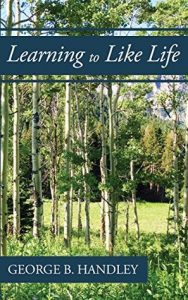 George B. Handley. Learning to Like Life: A Tribute to Lowell Bennion. Self.
George B. Handley. Learning to Like Life: A Tribute to Lowell Bennion. Self.
This book is meant to honor Lowell Bennion’s legacy by reflecting on what he taught and practiced in his own life, and thinking about what this can mean in our own lives today. All of Doc’s aphorisms imply a simple principle: our goodness and happiness must begin in the heart and depend on the quality of our affections, and, perhaps most importantly, we have the capacity to change those affections through a kind of cultivation. “Learn to like,” he repeats. Don’t assume that what you like is unchangeable, deeply rooted in your personality like some genetic code. Our affections stem from what we serve and devote ourselves to, and even if we don’t yet love as we should, it is enough to want to love better, more deeply, more generously. And loving is a way of practicing what we like.
A Professor of Interdisciplinary Humanities at Brigham Young University, George B. Handley’s creative writing, literary criticism, and civic engagement focus on the intersection between religion, literature, and the environment. A literary scholar and ecocritic whose work is characterized by its comparative reach across the cultures and landscapes of Latin America, the Caribbean, and the United States, he is also known for creative writing that blends nature writing, theology, and family history. He is an advocate for and scholar of environmental stewardship within Mormonism. His publications include two books on inter-american themes: Postslavery Literatures of the Americas: Family Portraits in Black and White (2000) and New World Poetics: Nature and the Adamic Imagination of Whitman, Neruda, and Walcott (2007). His book Home Waters: A Year of Recompenses on the Provo River (2010) is a work of creative non-fiction that includes nature writing, personal and environmental history, and reflections on ecotheology. It was received an AML Memoir Award. His environmentally themed novel, American Fork, will be published later this year.
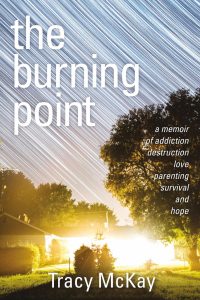 Tracy McKay. The Burning Point. BCC Press.
Tracy McKay. The Burning Point. BCC Press.
A Memoir of Addiction, Destruction, Love, Parenting, Survival, and Hope. I’m scared. No, you’re not. Yes, I am. Of what? What if I can’t do it? What if you can? When the call came, when the letter arrived, when the sunlight finally fell on your face–the struggle fell away, and you only remembered the beauty. It was like childbirth, but constantly, for your whole life. Every day we brought forth our future, every choice we made determined what raw materials would be in the hands of tomorrow. Some days took years and were times of transition where we thought we might die, and some years were full of euphoria or rushing release. Most years were slightly uncomfortable until we remembered how to breathe. Everything didn’t always work out. Sometimes things were just hard. Sometimes life hurt too much, and people did break. Sometimes, you had to wait for a long time for the sun to rise. While it’s true the sun always rose, not everyone lived through the night, and the stars didn’t give a damn.
Tracy was born and raised in the San Francisco Bay Area by gently agnostic hippies who are still mourning her assimilation into the Mormon collective. After doing everything wrong, Tracy went back to school as a divorced single mom and graduated Magna Cum Laude in 2012. Tracy relocated from the west coast to the DC metropolitan area, where she and her husband Jonathan are raising their combined family, and life rolls on in its messy, beautiful way. Her essays appear at the blogs By Common Consent and Dandelion Mama. The Burning Point is her first published book.
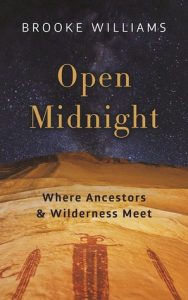 Brooke Williams. Open Midnight: Where Ancestors and Wilderness Meet. Trinity University Press.
Brooke Williams. Open Midnight: Where Ancestors and Wilderness Meet. Trinity University Press.
Open Midnight weaves two parallel stories about the great wilderness—Brooke Williams’s year alone with his dog ground truthing wilderness maps of southern Utah, and that of his great-great-great-grandfather, who in 1863 made his way with a group of Mormons from England across the wilderness almost to Utah, dying a week short. The book is also about two levels of history—personal, as represented by William Williams, and collective, as represented by Charles Darwin, who lived in Shrewsbury, England, at about the same time as Williams. As Brooke Williams begins researching the story of his oldest known ancestor, he realizes that he has few facts. He wonders if a handful of dates can tell the story of a life, writing, “If those points were stars in the sky, we would connect them to make a constellation, which is what I’ve made with his life by creating the parts missing from his story.” Thus William Williams becomes a kind of spiritual guide, a shamanlike consciousness that accompanies the author on his wilderness and life journeys, and that appears at pivotal points when the author is required to choose a certain course. The mysterious presence of his ancestor inspires the author to create imagined scenes in which Williams meets Darwin in Shrewsbury, sowing something central in the DNA that eventually passes to Brooke Williams, whose life has been devoted to nature and wilderness.
Brooke Williams has spent the last thirty years advocating for wilderness. He is the author of four books, including Open Midnight, Halflives: Reconciling Work and Wildness, and The Story of My Heart, by Richard Jeffries, as rediscovered by Brooke Williams and Terry Tempest Williams. His journalistic pieces have appeared in Outside, Huffington Post, Orion, and Saltfront. He and his wife, Terry Tempest Williams, divide their time between Utah and Wyoming.
Notable Mentions
The Creative Non-Fiction judges would also like to acknowledge the following books as “notable mentions”.
Matthew James Babcock. Heterodoxologies: Essays. Educe Press.
Kari Ferguson. The OCD Mormon: Finding healing and hope in the midst of anxiety. Cedar Fort.
Michael Hicks. Do Clouds Rest? Dementiadventures with Mom. Self.
Religious Non-Fiction
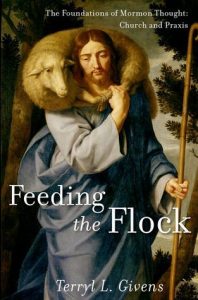 Terryl L. Givens. Feeding the Flock: The Foundations of Mormon Thought: Church and Praxis. Oxford University Press.
Terryl L. Givens. Feeding the Flock: The Foundations of Mormon Thought: Church and Praxis. Oxford University Press.
Feeding the Flock, the second volume of Terryl L. Givens’s landmark study of the foundations of Mormon thought and practice, traces the essential contours of Mormon practice as it developed from Joseph Smith to the present. Despite the stigmatizing fascination with its social innovations (polygamy, communalism), its stark supernaturalism (angels, gold plates, and seer stones), and its most esoteric aspects (a New World Garden of Eden, sacred undergarments), as well as its long-standing outlier status among American Protestants, Givens reminds us that Mormonism remains the most enduring–and thriving–product of the nineteenth-century’s religious upheavals and innovations. Feeding the Flock considers Mormon practice, the authority of the institution of the church and its priesthood, forms of worship, and the function and nature of spiritual gifts in the church’s history, revealing that Mormonism is still a tradition very much in the process of formation.
Terryl L. Givens did graduate work at Cornell University in intellectual history and at UNC Chapel Hill, where he received his PhD in comparative literature. He holds the Jabez A. Bostwick Chair of English and is Professor of Literature and Religion at the University of Richmond, where he teaches courses in nineteenth-century studies and the Bible’s influence on Western literature. His books include Wrestling the Angel: The Foundations of Mormon Thought vol. 1 (2014); The Oxford Handbook to Mormonism (with Phil Barlow, 2014, AML Special Award for Scholarly Publishing); The Columbia Sourcebook of Mormonism in America (with Reid Neilson, 2014); Parley P. Pratt: The Apostle Paul of Mormonism (with Matthew Grow, 2011, AML Award for Biography); When Souls had Wings: Pre-Mortal Life in Western Thought (2010); The Book of Mormon: A Very Short Introduction (2009); Joseph Smith: Reappraisals After Two Centuries (with Reid Neilson, 2008); People of Paradox: A History of Mormon Culture (2007, AML Award for Criticism); The LDS Experience in America (2004); By the Hand of Mormon: The American Scripture that Launched a New World Religion (2003); and The Viper on the Hearth: Mormons, Myths, and the Construction of Heresy (1997). He has also published, with Fiona Givens, The Christ Who Heals (2017); The Crucible of Doubt (2014), and The God Who Weeps (2012, AML Award for Devotional). Dr. Givens makes his home with Fiona in the village of Montpelier, Virginia amidst abundant woods and wildlife.
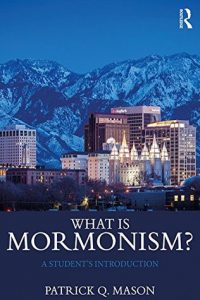 Patrick Q. Mason. What is Mormonism? A Student’s Introduction. Routledge.
Patrick Q. Mason. What is Mormonism? A Student’s Introduction. Routledge.
This short and lively book covers Mormonism’s history, core beliefs, rituals, and devotional practices, as well as the impact on the daily lives of its followers. The book focuses on the Salt Lake City-based church that is the largest and best-known expression of Mormonism, whilst also exploring lesser known churches that claim descent from Smith’s original revelations. Designed for undergraduate religious studies and history students, What is Mormonism? provides a reliable and easily digestible introduction to a steadily growing religion that continues to befuddle even learned observers of American religion and culture.
Patrick Q. Mason is the Howard W. Hunter Chair of Mormon Studies at Claremont Graduate University. He directs the Department of Religion’s programs in North American Religion and Mormon Studies, and also currently serves as department chair. He earned his graduate degrees from the University of Notre Dame in history and international peace studies. He previously held positions at the University of Notre Dame and American University in Cairo. He is the author of The Mormon Menace: Violence and Anti-Mormonism in the Postbellum South ( 2011) and Planted: Belief and Belonging in an Age of Doubt (2015). He is editor or co-editor of War and Peace in Our Time: Mormon Perspectives (2012); Directions for Mormon Studies in the 21st Century (2016); and Out of Obscurity: Mormonism Since 1945 (2016).
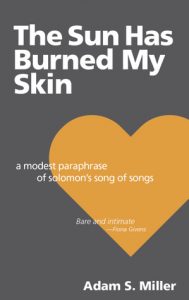 Adam S. Miller. The Sun Has Burned My Skin: A Modest Paraphrase of Solomon’s Song of Songs. BCC Press.
Adam S. Miller. The Sun Has Burned My Skin: A Modest Paraphrase of Solomon’s Song of Songs. BCC Press.
Like Adam Miller’s work on Ecclesiastes and Romans, The Sun Has Burned My Skin is a loose paraphrase that aims more for the replication of a certain mood than for the correspondence of particular words and phrases. The songs themselves are a collection of age-old Israelite love songs, searing and intense, sung principally by a young woman who is bold, confident, and only just exposed to the tidal pull of love and sex.
Adam S. Miller is a professor of philosophy at Collin College in McKinney, Texas. He earned a BA in Comparative Literature from Brigham Young University and an MA and PhD in Philosophy from Villanova University. He is the author of Future Mormon: Essays in Mormon Theology (2016), Letters to a Young Mormon (2014, revised second edition, 2018), Speculative Grace: Bruno Latour and Object-Oriented Theology (2013), Rube Goldberg Machines: Essays in Mormon Theology (2012), and Badiou, Marion, and St. Paul: Immanent Grace (2008). He received a 2011 AML Award for Personal Essay. He serves as the current director of the Mormon Theology Seminar. He and his wife, Gwen, have three children.
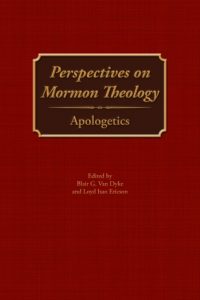 Blair G. Van Dyke and Loyd Isao Ericson, editors. Perspectives on Mormon Theology: Apologetics. Greg Kofford Books.
Blair G. Van Dyke and Loyd Isao Ericson, editors. Perspectives on Mormon Theology: Apologetics. Greg Kofford Books.
This volume in the Perspectives on Mormon Theology series is an exploration of Mormon apologetics—or the defense of faith. Since its very beginning, various Latter-day Saints have sought to utilize evidence and reason to actively promote or defend beliefs and claims within the Mormon tradition. Mormon apologetics reached new levels of sophistication as believers trained in fields such as Near-Eastern languages and culture, history, and philosophy began to utilize their knowledge and skills to defend their beliefs. The contributors to this volume seek to explore the textures and contours of apologetics from multiple perspectives, revealing deep theological and ideological fissures within the Mormon scholarly community concerning apologetics. However, in spite of deep-seated differences, what each author has in common is a passion for Mormonism and how it is presented and defended. This volume captures that reality and allows readers to encounter the terrain of Mormon apologetics at close range. Contributors include Van Dyke, Ericson, Daniel C. Peterson, Neal Rappleye, Benjamin E. Park, Ralph C. Hancock, Brian D. Birch, Juliann Reynolds, Julie M. Smith, Fiona Givens, David Knowlton, David Bokovoy, Joseph M. Spencer, and Seth Payne.
Blair G. Van Dyke is an independent scholar and teaches philosophy and religious studies at Utah Valley University. He is a Senior Research Fellow at the Foundation For Religious Diplomacy and is the Custodian of the Mormon Chapter of the Foundation. He holds a Doctorate in the philosophy of education from Brigham Young University. Van Dyke is the co-author of Holy Lands, A History of the Latter-day Saints in the Near East, and co-editor of a forthcoming volume entitled The Expanded Canon Mormonism and Sacred Texts. Loyd Isao Ericson received his B.S. in philosophy at Utah Valley University and pursued an M.A. in philosophy of religion and theology at Claremont Graduate Univeristy. Since 2009 he has been the managing editor of Greg Kofford Books and has been published in Sunstone, Element: The Journal of the Society for Mormon Philosophy and Theology, and the Claremont Journal of Mormon Studies, which he helped found.

